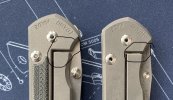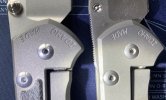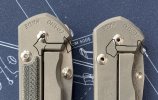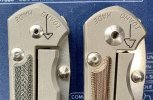Looking forward to hear your thoughts.
Ok...where to start...
As some of you know, I love my Large Sebenza 21’s. I use them in the bush, at work and for all the daily mundane tasks. The simplicity of a 21 is beautiful.
Now, I have had my Large Micarta CRK 31 now for a solid 48 hrs. I took it out of the box, jiggled for “lock flex,” frowned when I could feel it, and put it in my pocket to head off to work. I have used it for a few tasks at work so far and have already given it some “snail trails.” Now its mine forever.
I definitely will say that the 31’s “lockflex” is a lot more than I was anticipating. I have a few other nitpiks I will state before we get into this “lockflex,” if that is ok with you all.
First off, I love the inlays, if you have ever had to cut something with a grip that put the tips of your fingers between the inlays on the 21’s, than the 31’s inlays will feel amazing! However, the redesigned sculpting at the pointer finger relief, is a downfall to me. While it makes the 31 look so beautiful, it actually makes it so I can feel the “point” of the lockbar on my finger when pushing through material, or bearing down on the knife.
Second, and this is just my preference. I dislike the angled pocket clip...why oh why??
It lands in the middle of my palm and is really irritating...so chalk one up for Millit, as I will be purchasing one for this knife. Hopefully that clip, without its upward tail end protrusion, will be more comfortable. I never noticed a hotspot on my 21’s because of pocket clip placement.
Third, and short....if you have a hard time with the 21’s thumbstuds (no they havent changed) the 31, with its ceramic lockball integrated detent ball, makes the 31 a joy to open and close.
And that brings us to the new ceramic lockball interface...I will be the first to say this...I’m sorry I was “hard” on some of you BF members (if you believe i was). I have no fricking idea how CRK thinks this much “lockflex” is acceptable. Let me put it to you all this way...when I go out for work, I put the 31 AND my 21 in my pocket!! I know my 21 can handle the work safely, but can the 31? That is the question.
As much as I dislike the “lockflex,” I am commited to using the hector out of the 31 at work and home for the next 3 months, to see how it holds up.
Honestly, how this kind of “lockflex” is deemed acceptable from a company I hold in such high regards is unacceptable to me. They need to fix this asap. A minor amount of “lockflex” is normal for framelocks. This is not minor.
Almost done...the other issue I have with the ceramic lockball interface is that, in order for the “ball” to lockup around 50-70%, the actual lockbar sits close to 75-90% of the way, almost touching the presentation scale. This is before the “break in period.” A little worried about that, but we will see if it moves in the next 3 months.
That all being said, my Zaan, and all of my Sebenza 21’s have “lockflex” that I am totally fine with because that is the nature of the framelock lock geometry. They very in “lockflex” but not by much and is so slight you really have to push on the spine of the blade to feel it. My 31 is noticeable without using a table to push on the spine.
Now...like i stated in an earlier post, if I push the 31’s lockbar in a touch more, this “lockflex” goes away. If I roll it open, or thumbstud flick it open, the “lockflex” is noticable. So, in the next 3 months I will see if it wears to that further solid lockup point on its own. It must also be said that, if you grip the knife tightly, the lockbar moves to that tight lockup position.
I was trying to not be long winded, but failed miserably. Haha. So in closing, the jury is still out for me on the 31. I want to love everything about it, but it may take time. I may hate it...3 months time will tell.
Thank you for letting me ramble,
Ill leave you with a photo...
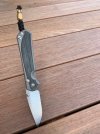
Keep ‘em Sharp



